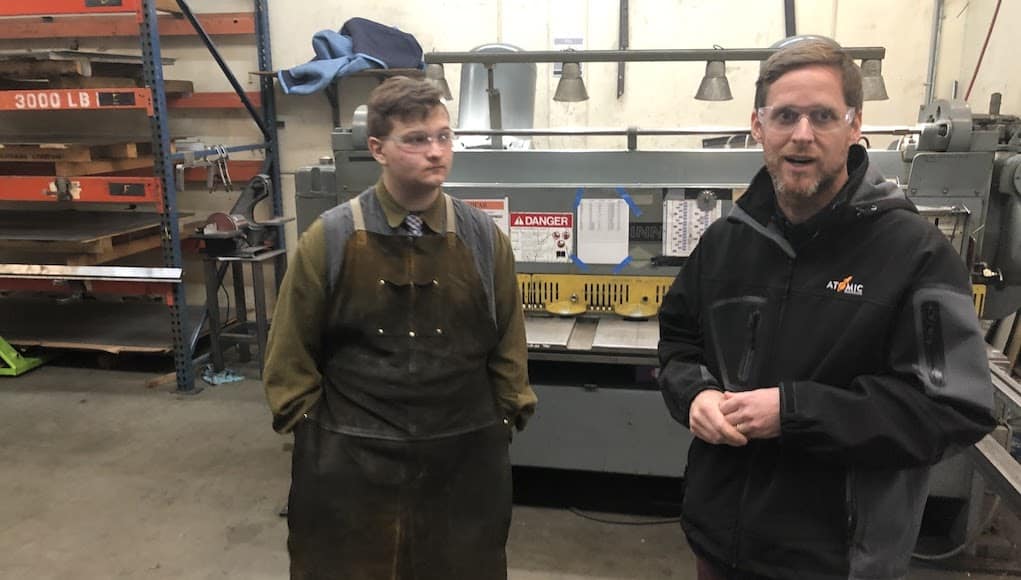Work Experiences Are as Important to Career Prep as School

Connor loved making things. When he learned his high school had a relationship with a metal fabricator, he applied for an internship. Patrick, the owner, appreciated Connor’s interest and created a variety of valuable experiences for Connor. Patrick learned project management and scheduling, problem-solving and root cause analysis, professional standards, and tolerances.
Near the end of his first year at the fabricator, Connor was fired for goofing off—another important lesson. After apologizing, Connor was rehired for a second year. He helped make improvements to the company’s website. His internship confirmed his career trajectory and helped the company build the manufacturing talent pipeline.
Work experiences can be as important as formal education (high school and college in particular) in terms of shaping career preferences and readiness. Left to chance, they may be few in number, inequitably distributed, and poorly supported. Instead, they should be built into the schedule and programming of every secondary and post-secondary institution.
The following are a few examples of schools and networks that do a pretty good job of ensuring that all learners have successful work experiences.
Big Picture. Students in the 65 U.S. Big Picture Learning (@BigPicLearning) schools participate annually in internships in high school often two days a week “with experts in their field of interest, completing authentic projects and gaining experience and exposure to how their interests intersect with the real world.” Big Picture is unapologetically learner-centered and puts systems in place to empower learners to pursue their interests.
Through their Imblaze app, students can create or find internships and then manage the acceptance process through a series of checklists. Imblaze also allows teachers to track attendance and monitor host feedback.
Connor attends Highline Big Picture, south of Seattle, where students attend internships two days a week. Host organizations range from manufacturing to retail to city government—anything relevant to a student’s career interest. Students and workplace hosts are well prepared for internship experiences with clear expectations and supporting visits from the school’s staff.
At San Diego Met High School, students spend Tuesday and Thursday at work experiences. An internship coordinator serves as a liaison between the Met, business partners, and the workplace mentor to ensure a minimum of three of the five Met learning goals are met. Teachers visit the internship site a minimum of three times to meet with the mentor and student.
Students earn attendance credit through independent study contracts. They present two exhibitions a year, in which they demonstrate how they have mastered the content standards and integrated the five Big Picture learning goals through their academic work and internships.
Across the Big Picture network, students participate in internships each year, allowing them to start in familiar and supported environments and move into more unfamiliar, complex and exploratory settings.
NAF. Students in the 618 career academies in the NAF (NAFCareerAcads) networks complete internships as juniors. They earn NAFTrack Certification requirements, which include:
- 120 hours or two 60+ hour internships
- Direct supervision by an accountable adult who is not the student’s teacher
- Producing work of value to an employer
- Written individualized learning plan connected to student learning outcomes
- Completion of the NAFTrack Internship Assessment by the student intern’s supervisor at the end of the internship.
- Interns are paid at no less than the applicable state or local minimum wage, which may be a youth minimum wage if permitted by state or local law.
Internships typically take place during the summer between the student’s junior and senior years of high school, but can also be done during the school year at a frequency that works with the student’s and employer’s schedule. Some schools have internship courses set up where students can earn credit for their internships.
Miami Dade has many good examples of schools providing work-based learning and paid internships. They are also piloting the implementation of NAFTrack with regional employers.
Linked Learning. ConnectED supports schools on a systemic approach called Linked Learning where students learn in career pathways and participate in internships.
At Clairemont High School in San Diego, 11th graders have a monthly meeting with a career path mentor (four students to each business mentor). Seniors take a semester-long course, Exploratory Work Experience, with a five-week Introduction (Essential Skills Bootcamp) and 10-12 weeks of work experience totaling at least 40 hours. Academy teachers visit each job site several times during the experience. Students build a portfolio of work, culminating with a senior capstone, that showcases essential career skills, ethical behavior, civic duty, and fiscal responsibility.
Professions-Based Learning. Southwest of Kansas City, the Blue Valley Center for Advanced Professional Studies (BVCAPS) is a next-gen career center providing part-time career-focused learning experiences in emerging job clusters.
“Most internships are a semester long and typically place a student in a workplace environment for 3-4 days a week for 2-3 hours per day. We do have students that find a work culture and employer they love and commit to longer time periods,” said Executive Director Corey Mohn.
BVCAPS placements have included Garmin, Cerner, Black & Veatch and Burns & McDonnell.
BVCPAS was so successful at promoting professions-based learning—at the center and on the job—it was replicated by districts in northeastern Kansas City and then nationwide. The CAPS Network (@NetworkCAPS) has 56 affiliates representing 112 school districts in 16 states (and a partner in India).
“Every CAPS affiliate is different in approach to internships, and that is intentional – our framework allows for local affiliates to flex to meet local conditions,” explained Mohn. “The one consistent component is that all CAPS affiliates will place at least a portion of students into internships before graduation.”
He noted that Northland CAPS in Kansas City places all 350 students in a second semester internship.
Work In and Out of School. Dubiski Career High School in Grand Prairie, Texas, is a large career focused high school with 15 career pathways in three academies. Most students have internships and more than half of these are with organizations outside of Grand Prairie. The school provides transportation to the internships. Dubiski students also gain work experience running a bistro, a student store, a salon, a print shop, and a quick lube—all open to the public.
Flexible Scheduling. Kenton County, Kentucky seniors can apply for an internship in their career pathway. The internship can vary in length, may be paid or non-paid, and could lead to course credit if all criteria are met. Students who complete at least 400 hours of a work-based learning experience program receive two hours of high school credit. The Academic Internship takes place at the training site of the mentor and will be a component of a scholar’s schedule either during the regular school day, after school hours, or during the summer, and may be one semester, one or more trimesters, or a yearlong experience.
Well structured internships can be the most valuable learning experience in high school. They confirm career interests and motivate further studies. Equally importantly, they can solve what a Big Picture principal called “the puppy problem,” where a student gets a dog and think they want to become a veterinarian.
If you’re a secondary school leader, make internships a priority in your schedule, budget, and staffing. If you’re a business owner or organizational leader, support high school and college work experience programs and help grow your business and your community.
For more, see:
- #IRL: 20 Tips for Real Life Learning
- Career Academy Giant NAF Gets an Upgrade, Expands Access to Work-Based Learning
- ConnectEd Links Learning to Career Pathways
- Mobile App From Big Picture Learning Identifies and Manages Student Internships
Stay in-the-know with innovations in learning by signing up for the weekly Smart Update.
This blog was originally published on Forbes.







Tom Vander Ark
See RealClearPolicy post on rise of tech apprenticeships https://www.realclearpolicy.com/articles/2019/11/20/apprenticeship_programs_reach_an_inflection_point_111312.html
Tom Vander Ark
internships stack into degrees in Georgia https://www.chronicle.com/article/New-2-Year-Degree-Promises/247600